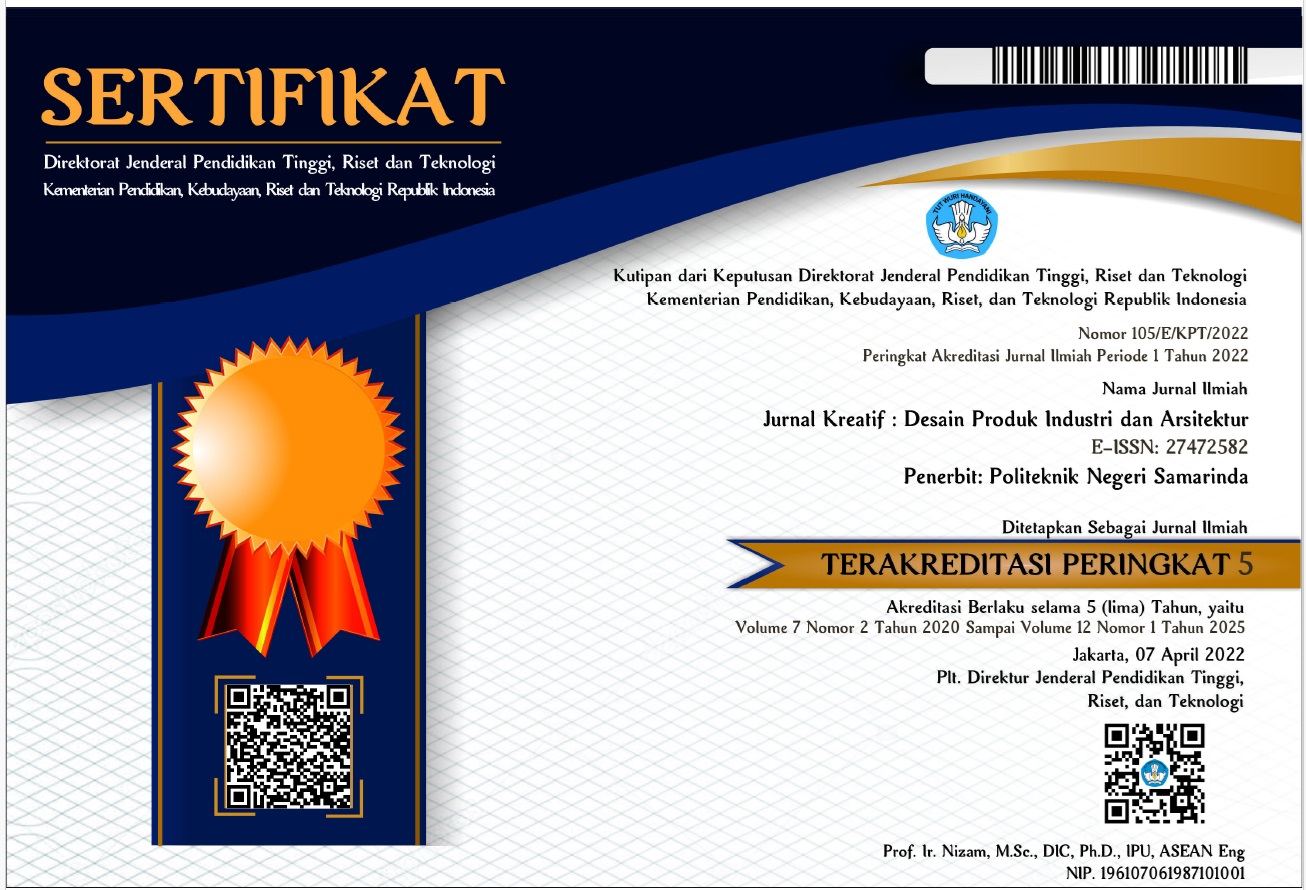PENGARUH POSISI SAMBUNGAN KONSTRUKSI KAYU TERHADAP DEDAIN PRODUK MEBEL BERBAHAN DASAR KAYU
 Abstract views: 724
,
Abstract views: 724
,
 pdf downloads: 711
pdf downloads: 711
Abstract
Wood furniture products were one of the commodities that have a dominant contribution compared to other furniture materials to the Indonesian economy. In furniture products, the connection system was a weak point in the construction, so a detailed analysis was needed regarding the factors that affect the strength of the construction and the effectiveness of the wood connection system. The purpose of this study was to determine the quality of the wood used as outdoor chair material by carrying out several tests to obtain wood density, moisture content, MOR and MOE values and then carrying out impact tests on actual outdoor chair products. The results showed that the teak wood used in the raw material for making the product had a moisture content of 12% with an average density of 0.68 g/cm3. The results of the static flexural strength test showed that the MOE of the tested teak was 107,108 kg/cm2 and the MOR value was 1,018 kg/cm2. The compressive strength value parallel to the fiber is 536 kg/cm2. The teak sample tested was included in strong class II which is quite strong as a raw material for furniture such as outdoor chairs. Analysis of the results of the construction design found that the type of construction used was tenon mortise, cracks at the joints occurred because the tenon was too close to the head of the wood. Based on the product test results, after the product with a new construction design was made, by lowering the tenon mortise position 3 mm from the initial position. The crack that occurs in the product is caused by an error in product construction design and not from the quality of the product raw materials used.
Downloads
References
Basri E, W. I. (2013). Sifat Dasar Kayu Jati Plus Perhutani dari Berbagai Umur dan Kaitannya dengan Sifat dan Kualitas Pengeringan. Jurnal Penelitian Hasil Hutan, 31(2).
Cai, L., & F., W. (1993). Influence of the stiffness of corner joint on case furniture deflection. Holz Roh Werkst, 5.
Hadjib N, Muslich M, & G., S. (2006). Sifat Fisis dan Mekanis Kayu Jati Super dan Jati Lokal dari Berbagai Daerah Penanaman. Jurnal Penelitian Hasil Hutan, 24(4).
Haygreen, J. G., & Bowyer, J. L. (1996). Forest product and wood science: an introduction. Hasil hutan dan ilmu kayu: suatu pengantar. Terjemah Sutjipto A.H. . Yogyakarta: Gadjah Mada University Press.
Hidayati F, Fajrin IT, Ridho MR, Nugroho WD, Marsoem SN, & M, N. i. (2016). Sifat Fisika dan Mekanika Kayu Jati Unggul "Mega" dan Kayu Jati Konvensional yang Ditanam di Hutan Pendidikan Wanagama, Gunungkidul, Yogyakarta. Jurnal Ilmu Kehutanan, 10(2).
Kasal, A., Smardzewski, J., Kuşkun, T., & Erdil, Y. Z. (2016). Numerical analyses of various sizes of mortise and tenon furniture joints. BioRes, 11(3), 6836-6853.
Kılıç, H., Kasal, A., Kuşkun, T., Acar, M., & Erdil, Y. (2018). Effect of tenon size on static front to back loading performance of wooden chairs in comparison with acceptabel design oads. BioRes, 13(1), 256-271.
Martawijaya A, Kartasujana I, Kadir K, & SA, P. (2005). Atlas Kayu Indonesia Jilid 1 (Vol. 1). Bogor: Pusat Penelitian dan Pengembangan Hasil Hutan.
Perindustrian, K. (2015). Laporan kinerja kementerian perindustrian. Jakarta: Biro Perencanaan, Kementerian Perindustrian.
Sunardianto. (2012). Teknologi kayu bambu dan serat. Malang: Fakultas Teknologi Pertanian. Universitas Brawijaya.
Tankut, A. N., & Tankut, N. (2010). Section modulus or cornet join in furniture frames as engineering design criteria for their efficient construction. Elsevier Material and Design, 32.
Copyright (c) 2023 Bahtiar Rahmat

This work is licensed under a Creative Commons Attribution-ShareAlike 4.0 International License.
Authors who publish with this journal agree to the following terms:
- Copyright on any article is retained by the author(s).
- The author grants the journal, right of first publication with the work simultaneously licensed under a Creative Commons Attribution License that allows others to share the work with an acknowledgment of the work’s authorship and initial publication in this journal.
- Authors are able to enter into separate, additional contractual arrangements for the non-exclusive distribution of the journal’s published version of the work (e.g., post it to an institutional repository or publish it in a book), with an acknowledgment of its initial publication in this journal.
- Authors are permitted and encouraged to post their work online (e.g., in institutional repositories or on their website) prior to and during the submission process, as it can lead to productive exchanges, as well as earlier and greater citation of published work.
- The article and any associated published material is distributed under the Creative Commons Attribution-ShareAlike 4.0 International License













